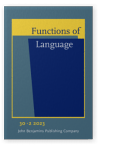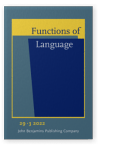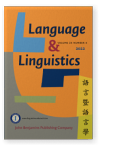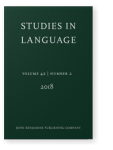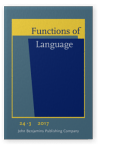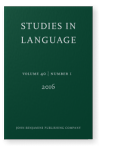Haiping Long
List of John Benjamins publications for which Haiping Long plays a role.
2023 Do ‘say’ verbs really grammaticalize into complementizers through clause combination? Evidence from Chinese shuō ‘say’ Functions of Language 30:2, pp. 137–158 | Article
When a ‘say’ clause is combined with a quoted-speech clause, one of two hypothetical pathways may be followed: (a) a complementation pathway on which the ‘say’ clause takes the quoted-speech clause as its complement clause and thus becomes its matrix clause; (b) a conjoining pathway which… read more
2022 Formation of Modern Chinese speech-quotative nǐ shuō ‘you say’ and feedback-seeking nǐ shuō ‘you tell me’: Two grammaticalizational pathways Language and Linguistics 23:4, pp. 743–777 | Article
In Modern Chinese, four construction types involving nǐ shuō may be distinguished. In this study, it is argued that the prosodically unseparated speech-quotative nǐ shuō (S1) develops from the prosodically separated speech-quotation nǐ shuō (S3) through a hypothesized complementation pathway… read more
2021 Chapter 1. On the rise of discourse markers Studies at the Grammar-Discourse Interface: Discourse markers and discourse-related grammatical phenomena, Haselow, Alexander and Sylvie Hancil (eds.), pp. 23–56 | Chapter
Discourse markers exhibit a range of grammatical properties that set them apart from many other lexical and grammatical forms. A number of hypotheses have been proposed to account for these properties. Most commonly, such accounts have drawn on grammaticalization theory, less commonly also on the… read more
2021 On the formation of a conjecturing clause-taking predicate in Modern Chinese: A conjoining account of huaiyi Functions of Language 28:2, pp. 183–207 | Article
This article claims that the conjecturing clause-taking huaiyi predicate in Modern Chinese (e.g. Renmen huaiyi zheming taoyi de jingcha hen keneng canyu le zheqi anjian. ‘People conjecture that the escaped policeman had probably been involved in the case.’) is actually a parenthetical structure.… read more
2020 Chapter 2. Dual process frameworks on reasoning and linguistic discourse: A comparison Grammar and Cognition: Dualistic models of language structure and language processing, Haselow, Alexander and Gunther Kaltenböck (eds.), pp. 59–89 | Chapter
The objective of the present paper is to compare two kinds of research traditions that developed in the course of the last decades to understand mental and linguistic processing. One tradition relies on the perspective and methodology commonly used in social psychology, cognitive psychology and… read more
2018 On the Formation of Modern Chinese Pseudo-Possessive-Object Constructions Studies in Language 42:2, pp. 297–328 | Article
Modern Chinese Pseudo-Possessive-Object Constructions (shortened as Modern Chinese PPO constructions; e.g. ta shuo le wo de haohua (他说了我的好话) ‘he has put in a good word for me’ and ta chi le wo de doufu (他吃了我的豆腐) ‘he has taken advantage of me’) are actually constructions displaying… read more
2017 Modern Chinese confirmative shi : Auxiliary or adverb? Functions of Language 24:3, pp. 294–318 | Article
Modern Chinese confirmative shi (as in mei cuo, wo shi yao dusi ni (沒錯,我是要毒死你) ‘that’s right. I really wanted to poison you to death’) is not an auxiliary but an adverb. It derives from the adjective shi ‘true, real’ in Old Chinese (Yan zhi yan shi ye (偃之言是也) ‘what Yan said was true’). The… read more
2016 Constructional change vs. grammaticalization: From compounding to derivation Studies in Language 40:1, pp. 137–175 | Article
Building on recent findings made in the framework of Construction Grammar, on the one hand, and within the framework on grammaticalization, on the other, the present paper is concerned with the development from lexical compounding to derivation. Compounding is presumably the most common source of… read more
